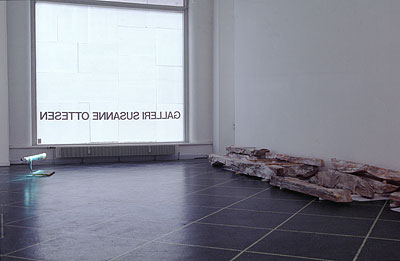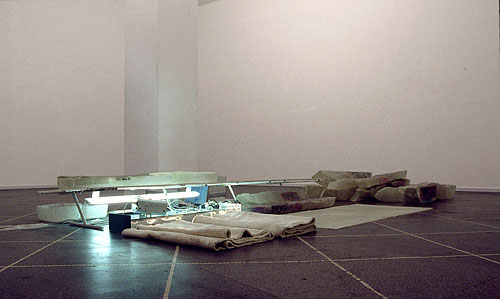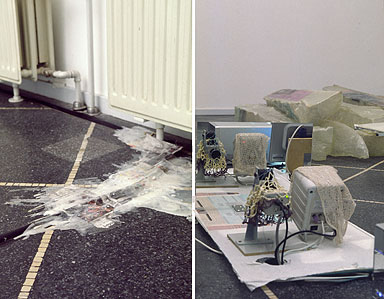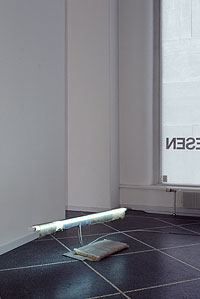MOVING TOWARDS DISSOLUTION
ON MARTIN ERIK ANDERSEN'S SCULPTURES
Martin Erik Andersen is the artist behind this sculpture, which is entitled It's All in the Eye or a Dreamer. Forbundne kar (skulptur i et rum) [Connected Vessels (Sculpture in One Room)] (2004) .

The background for this article is a conversation between the writer and Martin Erik Andersen conducted in August 2004.
One of the fundamental premises for Andersen's sculptural work is his basic trust in his material. It is not the connection between the materials that burdens him: on the contrary Andersen works from a concept of an open structure or, to put it differently he is attempting to explode structural coherence. He uses a wide diversity of materials, all able to propel artistic expression in countless different directions. It's All in the Eye or a Dreamer. Forbundne kar (skulptur i et rum) consists, as noted above, of the classic marble. In addition, we can see wood, tissue paper, machine knitwear, a neon tube and steel.
Andersen's sculpture is very appealing; it is aesthetic in the sense of being beautiful. This aesthetic dimension is an independent quality which is nonetheless to be seen as an integral part of the sculpture. At first glance, it is in the revelation of the material and its combination with other materials that the aesthetic element and the delicacy appear: the heavy, silent marble played against the soft, fine knitwear in subdued colours and the faintly gleaming neon tube covered with knitting, These juxtapositions give to the work a touch of poetic charm, At the same time, they open up a sensuous space for the viewer The aesthetics can be seen as a kind of adhesive binding all the elements together The delicate, fine knitwear endows large areas of the sculpture with a peculiar beauty. Andersen himself says that "the knitting machine is a fair place to give vent to one's aesthetic urges"
It is precisely because Andersen attempts to explode the overall structure of the sculpture by incorporating and joining together materials with different histories, modes of expression and possible connotations, that we need something to hold the work of art together in this connection, the aesthetic dimension is all important. The title, for example, might offer another point of reference for the viewer: not in the sense that the key to an understanding lies there but that it contributes to the imagery. It's All in the Eye off a Dreamer. Forbundne kar (skulptur i et rum) combines something very concrete and real in the form of the eye with something characterized by quite unrestrained associations: the dreamer This is also the point about the title of the exhibition at Galleri Susanne Ottesen of which the sculpture was a part, The general title of the exhibition was Af alle disse værelser er ingen blevet til [None of These Rooms Ever Were]. ' Etymologically, the Danish term "værelse" [room] is derived from "væren" [the state of being]. But whereas the word "værelse" is concrete and relates to space, "væren" is more diffused and airy. Language and aesthetics can offer two quite different ways of approaching Andersen's sculpture, If we examine the whole of the exhibition, complexity grows, by including different used materials which are already inscribed with meaning, the exhibition presents itself as a palimpsest. The exhibition consists of two works displayed in three separate spatial areas, The block of marble reappears as a polyester cast decorated with added pages fro m a Donald Duck magazine and the second work, It's All in the Eye of a Dreamer: Forbudne kar (skulptur i to rum) [Connected Vessels (Sculpture in Two Rooms)] (2004)

"Sculpture represents experiences of reality subjected to the logic of form. To produce sculpture is to develop logic of form, i.e. quite simply a logic.”4
A large part of Andersen's work is narrative and pictorial but there is much more to it. According to Andersen himself, the sculpture should be regarded as one focusing on detail. He notes, among other things, that not everything can be contained in one concept or in the narrative that is called sculpture.
As already noted, the titles are narrative and imaginative, though endowed with the power of fairy tales. The individual materials used may also be imaginative, especially when the connection of the body to the materials and the relations between these elements are stressed. Modern sculpture has always fought the body, both in the depiction of man's physicality, understood on the basis of a naturalistic conception of form, but also the body understood as a scale or measure by which our surroundings can be assessed.7 In many of his sculptures Andersen aims to establish a space for the body in relation to a rational architectonic space. In It's All in the Eye of a Dreamer. Forbundne kar (skulptur / et rum), he tries to inscribe the body in the sculpture by working outwards from a basic bodily structure which builds on horizontals and verticals and is linked to questions of weight, sight and direction.8 The markedly horizontal structuring of the marble creates a certain weight. The work orientates itself towards the floor. It unfolds lengthwise, and the viewer's eye follows it. In that way, the sculpture indicates a direction. In addition, Andersen works consciously on the task of translating the weight and size of the stones to a scale which is appropriate to the body. Colour, too, renders the marble figurative, in that it is close to the colour of the body. We have a rational organization of human proportions in relation to space, gaps, coordinates and material. The work can be understood as a potential frame for body and sight in space, rather than as a representation of body and sight. It creates a different form of representation from the purely figurative. Or, to put it differently, the sculpture is an example of a bodily representation which cannot be compared to the easy means by which the recognizable jumps out at the viewers and forces them to remain in a translatable world. An example of the silent element in the sculptures is the block of stone. To Andersen, the unbroken block of marble is inarticulate. Only when it has been worked up by the sculptor does language enter. The inclusion of the Donald Duck cartoon similarly allows silence to edge its way in, because the glue at certain points creates a film over speech bubbles and cartoon figures. In this way, the figurative and narrative elements are blocked out.

It is tempting to interpret the two sculptures with the shared title It's All in the Eye of a Dreamer. Forbundne kar as installations, for they occupy a considerable area of space and include a video projector and computer. But Andersen is consciously committed to sculpture. He talks of the Importance of the plinth, of volume and substance, and of the inscription of the body in the work. The tradition from which Andersen works was initiated by the explorations of the 1960s and the widening of the concept of sculpture.9 In 1987, ørskov published the essay Den åbne skulptur [The Open Sculpture]. In this, he established the point that the sculpture of the 1960s was not tied to a historical or individual system of references: "It is open in the sense that it does not refer, or if you will, refers to the entire world."l0 This openness or expansion does not in itself provide a particularly precise framework for the interpretation of a work or oeuvre.
It is true that Andersen has joined the ranks of those artists who, in the 1960s, endeavoured to expand the concept of sculpture. However, he works neither from a process-oriented perspective like Beuys, nor from an American minimalist one.
On the other hand it seems appropriate to compare Andersen's work to the Danish artist Ib Braase (born 1923). He is a very special exponent of the exploration of the open sculpture, Like Nørgaard he could be seen as a Danish parallel to the Arte Povera movement in Italy In his Fra min Iillesøsters værelse [From the Room or My Little Sister] made in 1971, Braase's constant preoccupation with proto sculptural problems combined with fragility and airiness can be intuited. The sculpture consists of four horizontal and four vertical wooden beams. Thanks to the title, the construction recalls above all the basic structure of a little girl's bunk bed. The beams are dotted with yellow and white paint and are put together with large visible nails. Small black pieces of bronze and iron are attached to some of the beams. The sculpture appears like a dream or a memory of something that once was. This is where the poetical element resides, and this is also the parallel to Andersen's sculpture, It’s All In the Eye off a Dreamer. Forbundne kar (skulptur i et rum) IS indeed on its way towards dissolution: its syntax is broken and for this very reason it can capture the viewer in a certain sensuous and poetical space.
To describe Andersen's particular logic of form further, ørskov may be brought into play once more. ørskov was concerned with defining syntax for sculpture: that is to say a formal grammar which could explain the connection and logic between the relations of individual elements. In his essay Skulpturens syntax [The Syntax or Sculpture] he writes:
"Instead of introducing reality in sculpture via the motif, we objectify it by trying to reach the truth in the principles, methods, coherence and/or functions applied."'2
The most Important point to underline in this connection is the concept of function, under which ørskov places the syntax of sculpture.
"Sculptural syntax implies the establishment of comprehensible functional connections within the sculpture, I call that a syntactic sculpture which is built on one or two leading functional principles and where individual parts are included as mutually necessary for and illuminating this coherence,"'3
The functional principles found in It's All in the Eye off a Dreamer. Forbundne kar (skulptur I et rum) can be defined as the partitioning of the block of marble, the dislocation of the pieces of marble, their being stacked on top of each other, and the holstering of wooden sticks. However, the fact that these principles are present does not imply that the work is a syntactically articulated construction. Indeed, Andersen tries to move his sculptures towards dissolution. They are on their way to dissolution. But they are always held back by the aesthetic language, their being bound to the body or the functional principles already mentioned.
ørskov indeed endeavoured to create a syntactically readable sculpture, but he was aware that the production of a logical sculpture, in addition to being a utopia, would have to be a sculpture that lacked poetry" The word poetry is indeed relevant in relation to Andersen's sculpture. It is important to underline the fact that in the movement towards dissolution of the sculpture -It's All in the Eye of a Dreamer: Forbundne kar (skulptur i et rum)-a large part of the attraction of the work resides in the poetry. Despite the fact that the sculpture gives away very few messages, the viewer is, as it were, kept busily occupied. Andersen notes that for him pictorial art acts in the periphery of language. It finds the places where language is not quite adequate. He talks of pictorial art creating new connections between the in-edible meanings which language gives to the world. Pictorial art can open up for a more fluctuating, fluent and moveable potential for meaning than language. In an earlier interview Andersen mentioned that nuances multiply when we lose language. Perhaps this is due to the fact that the movement towards dissolution of the syntax of sculpture implies a nuancing of both our language and our approach to the work, an approach which builds on both the concrete material and that which is fantastic, poetical or conspicuous by its absence.

Martin Erik Andersen was born 1964 in Denmark. He lives and works in Copenhagen. Andersen trained at the Royal Danish Academy of Fine Arts in Copenhagen 1985-92 and at El Fonuun-Gamila in Cairo, Egypt 1988-89. His work is represented in the collections of several Danish museums. Andersen received the Danish award Eckersbergmedaljen in 2004.
ARKEN's collection holds three sculptures by Martin Erik Andersen: It's All in the Eye of a Dreamer Forbundne kar (skulptur i et rum), 2004, Lampestrik, 1999, Forskalling med vægarbejde. 1996 The sculpture forms part of the exhibition Af alle disse værelser er ingen blevet til ~ Gallen Susanne Ottesen, Copenhagen 2004
Horsens Kunstmuseum in Denmark has acquired the other sculpture in the exhibition. It is entitled: it's All in the Eye of a Dreamer. Forbundne kar (skulptur i 10 Willy ørskov: "Skulpturens syntaks" (: 964) In Aflæsning of objekter og andre essays (Copenhagen: Borgens forlag. 1999), p. 59 Conversation between the writer and the artist August 2004
ørskov writes in his preface to Aflæsning af objekter og andre essays that a characteristic of modern sculpture is "its moving away from language. Rodin's 'Thinker', for instance, is 'linguistic' and can be seen as communication. It seems to be created and to express itself via a linguistic logic and syntax. A column by Brancusi or- a mobile by Calder, on the other hand, are 'non-linguistic' And to the same degree that this removal from language takes place, sculpture seeks its own area, its own syntax, it tends towards direct cognition (In a sensory, intellectual, metaphysical way) "Willy ørskov, op. cit
7 Andersen himself mentions that he works from a consciousness of different traditions. One of these has its roots in the Roman architect Vitruvius and his dissertation De Architecture (from about 35-25 Be. In these volumes Vitruvius unfolds his studies and reflections on the use in classical architecture of the human proportions as a yardstick for all good. harmonious building. Knowledge of Vitruvius' canon and the influence of reason on beautiful proportions, which Vitruvius postulates. were spread by Leonardo da Vinci in the Renaissance and Palladio in the 16th century_
8 Because Andersen works with this coordinate of horizontals and verticals, it is essential that the sculpture be placed along a wall. The horizontal movement of the work can be seen in contrast to the height and generally vertical orientation of the wall
9 The American art historian Rosalind E. Krauss describes the field and logic of the expanded concept of sculpture re in her seminal article "Sculpture in the Expanded Field" On The Originality of the Avant-Garde and Other Modemist Myths (The MIT Press. 1996), pp. 276-291
10 Willy ørskov: "Den åbne skulptur" in Den åbne skulptur og udvendighedens æstetik (Copenhagen: Sorgens forlag, 1987), p. 20
11 Two important exhibitions have often been mentioned as having helped to spread the knowledge of minimalist, system-oriented sculpture In Denmark. One is the Summer Exhibition in Arhus entitled 9 Skulpturer - En udvidelse af et bymiliø 1967.The other is Anonymiteter. Kommunikationszoner in Lunds Konsthall, 1968. Among the participants here were: Hein Heinsen, Mogens Møller, Peter Bonnen, Stig Brøgger, Hans-Jørgen Nielsen, Per Kirkeby and Peter Louis-Jensen
12 Willy ørskov: "Skulpturens syntaks," op. cit. p. 56 13 Ibid" p. 57
14 Mikkel Bogh: "Skulpturen. tiden og verden" in Dansk skulptur i 125 år (Copenhagen: Gyldendal. 1996), p. 228
15 Andersen in an interview with John Kørner INV\f'N.Kopenhagen.dk. 7_ December 2000